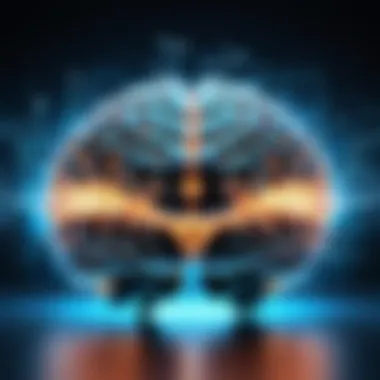Enhance Your Memory: Advanced Retention Strategies


Intro
In the fast-paced world we live in, keeping our memory sharp is becoming more and more vital. Advances in technology and research continue to shed light on how our minds work, giving us tools and strategies to bolster memory retention effectively. This journey into understanding memory isn’t just for the scholars or researchers; it’s for anyone eager to enhance their cognitive abilities.
Memory isn’t simply a mental file cabinet where information is stored. It's a complex mix of processes influenced by numerous factors, including our lifestyles and how we practice recall. Understanding these processes is key to implementing effective strategies that can help us retain more information for longer periods.
Whether you are a student aiming to ace your exams, a professional wanting to retain critical information, or someone simply keen on self-improvement, mastering memory techniques can make a significant difference. This article will cover a variety of methods, from traditional mnemonics to the latest digital applications that assist in memory enhancement, catering to a wide range of learning styles and preferences.
By providing practical tools based on proven strategies, we aim to equip readers not only to remember more but to optimize how they absorb and retrieve information, ultimately making learning a more effective and enjoyable experience.
Technology Insights
Latest Tech Trends
Recent technological advancements have revolutionized the way we approach memory retention. Smart applications and digital tools are breaking down barriers to effective learning. For instance, apps like Anki leverage the power of spaced repetition, transforming memorization into an intuitive process. By using spaced intervals, users can boost their retention rates significantly.
Moreover, wearable technology, such as memory-enhancement devices, employs neural feedback to help users train their brains. These devices, while still in their infancy, hint at a future where our understanding of memory can evolve with tech innovations.
Innovation in Tech
Innovative methods have also emerged concerning brain training games. Platforms like Lumosity employ tasks designed to target various cognitive skills, including memory. These games can adapt to the user’s skill level, keeping the experience challenging and engaging. The key lies in consistent practice, akin to lifting weights for mental agility.
Product Reviews
- Anki: This flashcard app is favored among students for its effectiveness in memorizing vocabulary and facts through spaced repetition. The user interface is straightforward, but the backend algorithm is where the magic happens, allowing efficient recall.
- Lumosity: Packed with a variety of brain games, Lumosity focuses on mental flexibility, problem-solving, and, crucially, memory. Users often find their cognitive abilities improving as they regularly engage with the games offered.
- Fit Brains Trainer: This app focuses on a holistic approach to brain training, blending memory exercises with mood boosters. Incorporating engaging tasks alongside challenges to memory makes this app a favorite among avid learners.
To wrap it up, the advancements in technology are creating opportunities for everyone to enhance their memory. However, it’s essential to select the right tools and cultivate a responsible habit toward usage, ensuring that technology complements our natural memory capabilities rather than becoming a crutch.
"Learning is not achieved by chance; it must be sought for with ardor and diligence." - Abigail Adams
Understanding Memory Retention
Grasping the principles behind memory retention is crucial for anyone aiming to elevate their cognitive skills. In this age of information overload, knowing how to effectively retain data can set individuals apart in both personal and professional arenas.
Memory retention shapes our ability to learn, recall information, and apply knowledge in practical situations. When one understands memory retention, they can develop techniques and habits that enhance their cognitive functions. This not only facilitates better academic performance but also enriches everyday interactions and decision-making processes.
Here are several key elements that underline the significance of memory retention:
- Enhanced Learning: Delving into memory processes allows individuals to absorb and retain material more efficiently, leading to deeper understanding and mastery.
- Problem-Solving Skills: A solid memory aids in retrieving past experiences, critical when it comes to effective problem-solving.
- Communication Proficiency: Retaining information promotes articulate expression of thoughts and fosters more meaningful dialogues.
Overall, the focus of this article on memory retention techniques serves to offer practical insights that readers can immediately apply. Each section is designed to not only outline the underlying science of memory but also present actionable strategies that can be utilized in everyday life.
The Science of Memory
Memory isn't just a passive storage system; rather, it's a dynamic process involving intricate biological systems. The human brain, equipped with billions of neurons, engages in a constant dance of information processing. Learning something new triggers pathways in the brain, and with repetition, these pathways become stronger and more pronounced.
This forms the backbone of memory science. Understanding how the brain encodes, stores, and retrieves information is vital. It empowers individuals to harness their cognitive capabilities effectively.
Types of Memory
Memory can broadly be categorized into various types, each serving distinct functions.
Short-Term Memory
Short-term memory, often likened to a temporary chalkboard, holds a limited amount of information for a short duration. It's essential for immediate tasks, such as remembering a phone number long enough to dial it. Its key characteristic is capacity limitation—typically around seven pieces of information.
This aspect makes short-term memory a beneficial choice when handling brief, everyday tasks. However, its downfall is that without reinforcement, information slips away quickly. It thrives on attention, which makes focused engagement a must for retaining any information in this category.
Long-Term Memory
In contrast, long-term memory is akin to a vast library, capable of storing information indefinitely. It encompasses everything from facts learned in school to personal memories. The key characteristic here is durability, as it is less susceptible to forgetting than short-term storage.
Long-term memory is particularly advantageous for anyone wishing to retain knowledge for future use. However, not all information transferred to long-term memory is equally accessible. Without proper cues or context, it can become buried under layers of unrelated data.
Working Memory
Working memory can be viewed as a mental workspace, actively manipulating and updating information. It plays an essential role in tasks that require reasoning, comprehension, and manipulation of information. The ability to juggle multiple pieces of info simultaneously highlights its key characteristic of fluidity.
This makes working memory critical in academic and professional settings. One distinct advantage is its integration of both short-term and long-term memory processes, allowing for immediate application of learned material. Yet, it can quickly become overloaded, demanding effective memory management strategies to keep performance optimized.
Memory Processes
Understanding how memory functions involves recognizing the processes that form its foundation: encoding, storage, and retrieval.
Encoding
Encoding is the first step in transforming perceived information into a format that can be stored. Think of it as translating language into code. A key characteristic of encoding is its reliance on various techniques, such as semantic encoding, which involves linking new information to existing knowledge.
Effective encoding is vital since how information is encoded directly impacts its later recall. The strength and clarity of encoding dictate whether experiences and knowledge are easily retrievable in the future. Thus, engaging deeply with the material enhances encoding strength.
Storage


Storage refers to maintaining encoded information over time. It can be fleeting or long-term, depending on how the brain categorizes the data. This process is crucial as it determines what can be accessed later.
A key characteristic is the brain's ability to organize data in a structured manner, contributing to efficient storage. This organization enhances the likelihood of retrieving information when needed. However, the challenge lies in the fact that storage isn't infallible — interference and decay can lead to information loss, making effective storage strategies essential.
Retrieval
Retrieval is the process of accessing stored information when needed. Each time memories are recalled, they are reconstructively brought back into consciousness. The capacity for successful retrieval hinges on cues that trigger the access.
This process is significant in that it reflects the dynamic nature of memory; it evolves with each recollection. A key characteristic of retrieval is its reliance on associative memory — the relationship between cues and stored information. The downside is that retrieval can be fallible; relying too heavily on cues may lead to misremembering or forgetting entirely.
"The act of retrieval is not simply finding a memory but breathing life into it once again."
Understanding these facets of memory retention empowers individuals to adopt effective techniques tailored to their needs. Whether one seeks to improve study habits or enhance everyday recall, knowledge of these processes serves as a fundamental stepping stone toward achieving those goals.
Cognitive Techniques for Memory Enhancement
Cognitive techniques are invaluable tools in the quest for better memory retention. These strategies harness the mind's natural ability to learn and remember while adding structured frameworks to maximize effectiveness. By engaging actively with the material, a person can dramatically improve their recall abilities. The beauty of cognitive techniques lies in their versatility; they can be tailored to individual learning styles, making them highly relevant for knowledge seekers in our digital age.
Mnemonic Devices
Acronyms and Acrostics
Using acronyms and acrostics is like turning complex information into bite-sized pieces, making it easier to digest. An acronym, for instance, simplifies a string of words into a catchy phrase. Take NASA or RADAR. The ease of remembering them comes from the little twist on ordinary terms. This feature makes acronyms a prominent choice for study. However, they do come with a caveat: while they are great for memorizing lists or terms, they can risk oversimplifying complex subjects, potentially leading one astray in understanding.
Visualization Techniques
Visualizing information capitalizes on the brain’s ability to form mental images. Imagine trying to recall the elements of the periodic table by picturing a vibrant image of, say, a helium-filled balloon floating in the sky. This technique engages multiple senses, making it stickier in one’s memory. As a technique, it has strong practicality; however, the downside lies in the fact that not everyone is a visual thinker, and those less inclined to imagery might find this method challenging to use effectively.
Chunking Information
Chunking separates vast information into digestible segments, similar to how phone numbers are grouped together. Think about breaking down a 10-digit number into smaller, meaningful sequences, making it less daunting to remember. This method works wonders because it utilizes our cognitive limits efficiently. The downside? If one doesn't take the time to initially categorize the chunks, confusion can ensue when trying to recall the information down the line.
The Method of Loci
Spatial Memory Utilization
Spatial memory utilization leans heavily on the human brain's knack for remembering locations and environments. It’s like associating information with a familiar route, such as your childhood home or the way to school. This method stands out because it creates lasting connections, leading to better recall. Yet, it is limited by clarity. If the mental imagery of the locale is vague or muddled, the associated memories can end up lost in translation.
Creating a Mind Palace
The act of creating a mind palace is akin to building a virtual storage unit for your thoughts. You visualize a place, like your own home, and assign different items or ideas to specific rooms. This technique is celebrated for its effectiveness; the more vividly one can imagine the place, the stronger the recall will be later. However, it requires immense effort and creativity, which can be a significant barrier for those who struggle with visualization or spatial awareness.
Practical Examples
Practical examples breathe life into memory techniques. They illustrate how these strategies can be applied in real-life contexts. For instance, if you're preparing for an upcoming exam, consider using the method of loci by visualizing each room of your house filled with items related to what you're studying. This real-world application adds context, making it more relatable and easier to grasp. However, examples can sometimes lead to distractions, especially if one tries to remember too many contexts at once.
Storytelling and Narrative Techniques
Storytelling turns information into narratives, leveraging the brain’s affinity for tales and plots. Instead of memorizing dry facts, you craft a story around them, making the material easier to recall. It capitalizes on emotional engagement, which is crucial for memorability. This method's drawback? It can veer into embellishment, leading to inaccuracies. For someone looking to use storytelling effectively, the balance between creativity and factual integrity is key.
"The stories we tell ourselves and others are an integral part of how we understand and remember the world."
Whether it’s mnemonic devices, the method of loci, or narrative techniques, the blend of cognitive science, creativity, and personal insight is what enhances memory retention and paves the way for effective learning.
Physical and Lifestyle Factors Impacting Memory
Understanding how physical and lifestyle factors influence memory retention is crucial in this exploration of cognitive enhancement. Many people spend hours focused on techniques like mnemonics or the method of loci, but often overlook the foundational role that lifestyle choices play in optimizing cognitive function. Factors such as nutrition, hydration, sleep, and exercise don't just support brain health; they can profoundly impact memory. By integrating these elements into a comprehensive strategy, individuals can enhance their memory retention significantly.
Nutrition and Memory
Brain-Boosting Foods
When we think about enhancing memory, food is often the last thing that comes to mind. However, the type of food we consume can either help or hinder cognitive function. Brain-boosting foods, such as blueberries, fatty fish like salmon, or dark chocolate, are rich in antioxidants and omega-3 fatty acids. These nutrients are known to support brain health, improve mood, and even protect against cognitive decline. A standout feature of these foods is their ability to reduce inflammation in the body, which is essential since chronic inflammation can impair memory processes.
Key takeaway: Including brain-boosting foods in your diet is a no-brainer if one wants to improve memory retention.
However, it's also important to note that not all marketed brain foods hold the same promise. For instance, while some claim benefits from superfoods, the evidence for their efficacy can vary greatly.
Hydration and Cognitive Function
Staying hydrated is a cornerstone of healthy brain function. Dehydration can lead to fatigue, confusion, and a notable dip in cognitive performance. Water is essential for the brain to function efficiently; it helps in nutrient transportation and waste removal critical for memory processing.
What sets hydration apart is its immediate impact on cognitive tasks. Studies show that even mild dehydration can impair attention and short-term memory. Therefore, making hydration a priority is a simple yet effective way to boost memory retention.
Caution is advised: Some beverages, like those high in sugar or caffeine, can lead to dehydration, counteracting the benefits.
Sleep's Role in Memory Consolidation
When speaking of memory retention, sleep is the unsung hero. It’s during sleep that our brains consolidate memories. This process is vital, as it transforms short-term memories from the daily grind into long-term memories that we can recall later. Furthermore, adequate sleep not only improves retention rates but also enhances creativity and problem-solving skills.
The challenge many face today is the sleep deprivation epidemic. Many prioritize work or leisure activities over their sleep schedules, which can lead to forgetfulness and impaired cognitive functions. What one may not realize is that simply getting those seven to nine hours can make a world of difference in memory performance.


Physical Exercise and Its Benefits
Aerobic Activities
Engaging in regular aerobic activities, like running, swimming, or cycling, has been linked to improved memory and cognitive function. These activities increase heart rate and blood flow to the brain, facilitating the delivery of oxygen and nutrients essential for maintaining cognitive health. One specific aspect of aerobic exercise is its ability to promote the creation of new neurons—this process, known as neurogenesis, can enhance overall brain function.
Why aerobic exercise is a good choice for memory: It combines physical activity with potential stress relief, fostering a holistic improvement for brain functionality.
Consider adopting a routine that includes at least 150 minutes of moderate aerobic exercise per week, as guided by health organizations.
Mental Exercises
While physical exercise plays a pivotal role, stimulating the brain cognitively is equally important. Mental exercises, which include puzzles, reading, or even engaging in strategic games, can strengthen neural connections and improve memory retention efficiency. What makes mental exercises distinct is their ability to challenge the brain in different ways.
Incorporating varied mental exercises into daily routines not only keeps the brain agile but also adds an element of fun to learning new information. However, it's essential to establish a balance—too much focus on one type of exercise can lead to a plateau in cognitive improvement.
Technological Aids for Memory Improvement
Memory improvement in this age is crawling hand-in-hand with technology. This interrelation is changing how we engage with learning material and how effectively we retain it. Advanced digital tools provide a support system that allows users to enhance their memory faculties in ways traditional methods may not match.
With the rapid growth of mental wellness and cognitive enhancement products, integrating technology into memory improvement strategies isn’t just a trend but a necessity. Whether one is grappling with a pile of information for exams or simply trying to remember to buy groceries, having reliable technological aids can serve as a personal assistant.
Memory Enhancement Applications
Overview of Popular Apps
When it comes to memory enhancement applications, the market is flooded with a variety of choices that cater to diverse needs. Apps like Anki, Quizlet, and Memrise stand out due to their specific capabilities aimed at improving memory retention.
Key Characteristic: One of the primary characteristics that make these apps popular is their ability to use spaced repetition, which is proven by research to strengthen memory retention. For instance, Anki allows users to create custom flashcards that adapt based on whether you got the answer right or wrong. The truly unique feature of many of these apps is their interactive nature, engaging users through mini-quizzes that can fit into even the busiest schedules.
The advantages include personalization, accessibility, and a community of users sharing decks and resources. However, disadvantages can include reliance on technology—what happens when devices fail or when one is not near their gadget?
Features and Usage
Delving deeper into the features of memory enhancement applications, we see a plethora of tools designed to aid in learning. Searchable databases, progress tracking, and customizable study modes are just the tip of the iceberg.
Key Characteristic: The interactive learning approach of these apps is their most compelling selling point. Instead of a passive reading experience, users are prompted to engage actively, which significantly boosts retention. Other features, like gamification—earning badges or points for completing tasks—keeps users motivated and makes learning feel less like a chore.
While users can track their progress and revisit their weak areas, a potential drawback could be overstimulation or distraction from notifications, which may hinder learning instead of helping it.
The Role of Virtual Reality
Immersive Learning Environments
Virtual Reality (VR) has been making waves in various fields, and its application in memory improvement is no different. Immersive learning environments present a unique way of experiencing information—imagine walking through a historical site while learning about it in real-time.
Key Characteristic: The primary allure of these environments lies in their ability to create a setting that makes information memorable. Experiences that feel real often leave a more lasting impression than rote memorization. Some unique features include 3D simulations and interactive scenarios that require users to engage physically, greatly enhancing the learning experience.
On the downside, accessibility can be a hurdle; not everyone has VR equipment, and the experiences can be somewhat costly to produce.
Practical Implications
As VR technology becomes more adept, its practical implications for memory retention are becoming undeniable. Training programs using VR can simulate real-world scenarios where trainees need to recall information on the spot. For example, medical students can practice procedures in a controlled environment.
Key Characteristic: The incredible realism makes it easier for learners to remember information. The hands-on approach combined with contextual immersion leads to stronger connections in memory. However, the challenges include the cost of the technology and potential difficulty in accessing high-quality content.
Memory is not just a capability; it’s a skill. The better the tools you have, the sharper your skills can become.
Specific Memory Retention Techniques
Specific memory retention techniques play a crucial role in enhancing our ability to learn and recall information effectively. These methods are not just tricks but grounded in cognitive science, focusing on how our brains process and store data. In an age where information is abundant and attention spans are shrinking, mastering these techniques can be a game changer for anyone looking to improve their cognitive capacity. This section delves into three pivotal methods: spaced repetition, active recall, and dual coding theory, each with distinct benefits and applications.
Spaced Repetition
Spaced repetition is a technique that leverages the psychological spacing effect—essentially, it's based on the idea that small, spaced-out study sessions can help hardwire information into your brain far better than cramming. The main principle here is simple: revisit information at increasing intervals before you forget it. This method isn't just effective; it can dramatically improve long-term retention of material.
When using spaced repetition, learners can utilize spaced repetition software (SRS), like Anki or Quizlet, to systematically schedule reviews. For instance, if you are learning a new language, you might first learn a set of vocabulary words and then revisit them after one day, then three days, then a week, and so forth. This technique essentially trains your brain to recall information just at the right moment when it's beginning to fade, optimizing your study time.
"Humans forget about 50% of the newly learned information within an hour, making spaced repetition an invaluable tool for anyone aiming to retain knowledge."
Active Recall
Active recall is another invaluable technique. Unlike passive review, where you might skim notes or textbooks, active recall involves actively engaging with the material. This can be as simple as testing yourself on the information you’ve just learned or summarizing concepts without the aid of your notes. For example, after reading a chapter in a textbook, jotting down everything you remember on paper can help solidify that knowledge.
This technique not only enhances retention but encourages deeper understanding as it forces your brain to retrieve information actively, reinforcing the neural pathways associated with it. Studies have shown that students who utilize active recall methods significantly outperform their peers who rely solely on passive learning techniques. Incorporating flashcards or even practice quizzes into your study routine can make this approach both effective and engaging.
Dual Coding Theory
Dual coding theory posits that we can enhance our memory retention by combining verbal and visual information. By using both words and images together, we create multiple pathways for retrieval. For instance, when learning about historical events, using timelines or infographics alongside reading can help solidify the information in your memory.
This technique is about more than just incorporating visuals; it's about finding ways to connect concepts in dynamic ways. Creating mind maps or diagrams can support complex topics, making them easier to digest and remember. Leveraging dual coding can benefit anyone from students to professionals trying to absorb detailed data efficiently. Combining various forms of input caters to multiple learning styles—a powerful strategy for mastering any subject.


By implementing spaced repetition, active recall, and dual coding theory, individuals can refine their memory retention strategies significantly. These techniques are not one-size-fits-all but can be tailored to fit diverse learning styles and needs, thus paving the way for enhanced cognitive functions and improved performance across various realms.
Evaluating Memory Retention Techniques
Evaluating memory retention techniques is crucial for anyone who aims to enhance their cognitive capabilities. As the world becomes more demanding, understanding how different strategies work will equip individuals with the knowledge to tailor their approach to memory improvement effectively. With an array of methods available, evaluating these techniques helps individuals determine what is most effective based on personal experiences and requirements. The distinct advantages that come with this process include identifying the best practices, minimizing wasted time on ineffective strategies, and ultimately improving one's ability to retain information.
Assessing Effectiveness
Personal Experimentation
Personal experimentation stands out as a critical aspect of assessing the effectiveness of memory techniques. This approach allows individuals to explore different methods and assess their effectiveness firsthand. The key characteristic of personal experimentation is its emphasis on individual input, tailoring techniques to match unique learning styles. Many people find it a beneficial choice within the scope of this article because it goes beyond theoretical knowledge to provide practical insights.
This method's unique feature lies in its trial-and-error nature, allowing individuals to discover what truly works for them. Among its advantages, personal experimentation fosters personal growth and boosts confidence in one’s cognitive capabilities. However, the downside is that it can be time-consuming, requiring patience and consistent effort to find the right fit.
Tracking Progress
Another essential component of evaluating retention techniques is tracking progress. This allows individuals to monitor their improvements over time, providing tangible evidence of effectiveness. The hallmark of tracking progress is the ability to quantify gains, translating seemingly abstract improvements into measurable results. It captures the attention of readers because, in a tech-driven world, metrics lend credibility to claims.
A distinctive feature of tracking progress is its reliance on data analysis. This means that individuals can use various tools and applications to visualize their success, pinpoint areas for further growth, and maintain motivation. Among the advantages, it establishes a feedback loop that can enhance performance. Nevertheless, it is also important to note that it may cause frustration if trends don't align as expected, leading to potential discouragement.
Tailoring Approaches to Individual Needs
Tailoring approaches to individual needs ensures that memory techniques resonate with the unique cognitive profiles of users. Everybody has different learning preferences, whether visual, auditory, or kinesthetic. Hence, customizing techniques provides a pathway to amplify memory retention effectively.
Recognizing these variances makes tailoring methods so beneficial. For instance, someone with a visual learning preference might find mind mapping more effective than reading comprehension alone. On the contrary, an auditory learner may excel through the use of storytelling techniques or audiobooks.
While the challenge may arise in the initial phase of learning which approach suits best, the long-term benefits of adopting a tailored strategy outweigh this inconvenience. Individuals can set realistic and achievable goals, leading to a more personalized experience that ultimately enhances overall performance.
Comprehensive Strategies for Memory Retention
Memory retention is a nuanced and critical capability, influencing everything from academic performance to everyday functioning. In this article, we emphasize techniques that not only improve the retention of information but also encourage a deeper understanding of the material in question. The importance of comprehensive strategies lies in their ability to cater to diverse learning styles, ensuring that all individuals, whether they connect with visuals, auditory signals, or kinesthetic actions, can find a method that resonates with them.
Combining Techniques for Maximum Efficiency
In the realm of memory enhancement, it often pays to wear multiple hats. By combining various techniques, individuals can achieve superior results compared to relying on a single method. For instance, merging mnemonic devices, like acronyms or visualization, with spaced repetition creates a robust framework for learning. This multitiered approach takes advantage of each technique's unique strengths and compensates for their weaknesses.
Consider this: you might remember the phases of the moon better if you visualize them while simultaneously practicing spaced intervals of review. Such combinations ensure the information clings better to memory. Here are some other combinations to consider:
- Active Recall + Dual Coding Theory: Test yourself while using visuals to reinforce learning.
- Pomodoro Technique + Spaced Repetition: Break study sessions into smaller chunks while revisiting material over increasing intervals.
- Mind Maps + Storytelling: Create diagrams that incorporate narrative elements to make the material more memorable.
"Learning is not the product of teaching. Learning is the product of the activity of learners." — John Holt
These combinations harness the power of neuroplasticity, allowing the brain to forge stronger connections while actively engaging with the information.
Creating a Personal Memory Retention Plan
Tailoring a memory retention plan is a personalized journey that paves the way for significant cognitive gains. A one-size-fits-all strategy doesn’t suit everyone. Instead, the creation of a plan necessitates a thoughtful introspection on what works best for the individual’s unique learning style.
Here’s a step-by-step guide for formulating your personal plan:
- Assess Your Learning Style: Understand if you are a visual, auditory, or kinesthetic learner. Each style has its preferred techniques.
- Set Clear Goals: What do you want to achieve? For example, retaining information for an exam, enhancing a skill set, or simply learning for pleasure.
- Select Techniques: Based on your style and goals, select a mix of techniques that resonate with you. For visual learners, this might mean opting for mind maps or infographics. Auditory folks might benefit from recordings of lectures or discussions.
- Establish a Routine: Consistent practice reinforces memory. Set aside dedicated times for review, employing strategies like spaced repetition to ensure retention over time.
- Monitor Progress: Evaluation is key. Keep a log of what works and what doesn’t. Adjust your plan as necessary based on effectiveness.
Creating such a plan engages individuals in the learning process while also instilling responsibility for one’s own cognitive growth. This custom strategy doesn’t just enhance memory retention; it fosters a lifelong learning attitude.
Future Directions in Memory Research
The landscape of memory research is continuously evolving, propelled by advancements in technology and an ever-growing understanding of the brain. In this article, we explore how future directions in memory research could offer not only innovative techniques for memory retention but also pave the way for new cognitive enhancements that may revolutionize educational and professional practices.
Emerging studies are signaling a shift toward a more integrated approach to memory improvement, considering both the mental and physical facets of cognition. By diving deep into the molecular mechanisms of memory formation and retention, researchers are laying the groundwork for significant breakthroughs. This future research will greatly benefit applications across various fields, including education, mental health, and workplace productivity.
"Memory is the treasure house of the mind wherein the monuments thereof are kept and preserved."
– Thomas Fuller
Emerging Trends and Technologies
Cognitive Enhancements
At the forefront of cognitive enhancements is the utilization of various technological tools designed to elevate memory performance. Significant developments like non-invasive brain stimulation techniques have started to gain popularity, as they show promise in improving both short-term and long-term memory. These methods primarily aim to enhance neural connectivity, which is essential for effective memory retention.
The key characteristic of cognitive enhancements lies in their ability to target specific brain regions associated with memory processing. This precision allows for more personalized approaches; thus, individuals can have tailored strategies according to their unique neurological makeup. The unique feature of these enhancements is that they often combine traditional learning techniques with cutting-edge technology, resulting in highly effective and adaptable memory aids.
Nevertheless, some concerns exist, such as the long-term effects of prolonged use, potential dependency, and ethical implications surrounding cognitive augmentation. Balancing the promise of innovation with caution is essential as we move forward in this field.
Ethical Considerations
As technology continues to intertwine with cognitive enhancement methods, ethical considerations become paramount. Discussions around what constitutes responsible enhancement of memory are gaining traction. A core aspect of these ethical considerations is the potential disparity in access to cognitive enhancement technologies. Not everyone may afford or have access to these innovations, creating possible divides in educational and professional achievements.
Highlighting responsibility in developing these technologies is similarly significant. Research should consider the implications of enhancing memory through potentially coercive means, especially in competitive environments like the job market. Unique features of ethical frameworks can include clear guidelines on testing and implementing cognitive aids, ensuring the overall well-being of users.
Both advantages of cognitive enhancements—that they foster better learning outcomes and have the potential to address memory-related disorders—come with the disadvantages of ethical concerns about fairness and autonomy. The debate continues, pushing for a more comprehensive view of cognitive enhancements in future research.
The Potential of Neuroplasticity
Neuroplasticity holds immense promise for informing future memory research. It refers to the brain's ability to adapt and reorganize itself throughout life. This fascinating capacity suggests that memory is not a static, unchangeable entity but a dynamic process that can be trained and molded.
Current findings indicate that engaging in diverse mental exercises and exposure to novel experiences can significantly enhance memory retention. This insight allows us to approach memory training not just from the angle of improvement, but also from an understanding that fostering an adaptable brain can yield substantial benefits.
The exploration of neuroplasticity can lead researchers to develop new methodologies for memory enhancement. Programs that leverage this potential can be integrated into educational structures, allowing learners of all ages to maximize their memory capabilities. Ultimately, understanding how neuroplasticity affects memory will not just bolster retention strategies but will also fundamentally alter how we perceive and teach cognitive skills.







